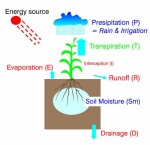
Irrespective of the new laws, the best argument to promote the effective
use of water is if one realises that a 10% saving in water actually means
that one can irrigate 10% more hectares. The objective of this article is
thus to review the basic factors influencing the water balance so that
effective water use can be implemented.
The water balance
The components of the soil water balance (SWB) are depicted in Figure 1. The
water balance can be summarised as in equation 1:
ÄSm = Sm + P – T – E – I – R – D Eq 1
Simply put, equation 1 states that the change in the soil water content (ÄSm)
over a period of time depends on the original water content (Sm) plus
precipitation (rain and irrigation, P) minus transpiration (loss of water by
plants, T) minus evaporation (loss of water from the soil surface, E) minus
interception (water held in the plant canopy, I) minus runoff (surface water
not penetrating the soil and running away, R) minus drainage (water draining
away below root zone, D).
The components
The only component in the water balance where water is used to promote crop
growth and yield, is transpiration. All the other components (E, I, R and D)
are a direct loss and waste of water. Basically, water is taken up by the
plant’s roots and transported to the leaves. The leaves are the plant’s
“factory” where solar energy is trapped and used to fix carbon dioxide (CO2)
and form plant building blocks, such as sugar and starch. For the plant to
do this, it must get CO2 from the air. Uptake of CO2 occurs when the stomata
in the leaves are open, but, by opening the stomata, the plants lose water.
In fact, water loss through the open stomata (transpiration) is the plant’s
tax for access to CO2. This is why there is a direct relationship between
transpiration and plant growth: the higher the transpiration, the greater
the plant’s growth. So, within reason, one must strive to keep transpiration
high (reduce water stress) to maximise yield.
Evaporation from the soil surface is a direct loss and waste of water.
Evaporation is primarily driven by the solar energy striking the soil
surface, the speed in which moist air is removed (wind) and the moisture
content of the soil. A wet soil facilitates high water loss if there is
energy to evaporate water. Thus, the best way to keep evaporation to a
minimum is to restrict solar energy reaching the surface (by using stubble
mulch) and not irrigate frequently. It is better to use deeper irrigations
at longer intervals than frequent light irrigations. Frequent light
irrigations keep the topsoil moist, thereby promoting evaporation.
Interception of water by the crop is directly related to the size and
density of the crop canopy. Normally, this component is minimal and rarely
exceeds about 2 mm to 5 mm. To keep interception minimal, the principle of
deeper irrigations at longer intervals applies.
Runoff occurs when the precipitation rate exceeds the water infiltration
rate into the soil. The infiltration rate is dependent on soil texture, soil
water content and soil structure. Little can be done about the soil texture
except to realise that sandy soils have higher infiltration and internal
redistribution rates than clay soils. A drier soil absorbs water quicker
than a moist soil, so the principle of deeper irrigations at longer
intervals will assist to reduce runoff. The practice of stubble mulch does
reduce runoff.
Uncontrolled drainage below the root depth is a waste of water. If there are
problems with salt, drainage does serve a good purpose by flushing salts out
of the root zone. However, if there are no drains to remove the excess salts,
the deep leached salts can re-enter the root zone through capillary rise
when the water table rises.
The soil moisture content is a very important component in the SWB. The
nearer Sm is to the field capacity (FC, i.e. effective maximum water holding
capacity), the easier water is available to the plants. As Sm approaches the
wilting point (effective lower limit of available water) so water is less
available to the crop. In essence, it is preferable to keep the Sm near FC.
However, if the soil is near FC and a useful rainfall (30 mm) occurs, there
is the possibility that the FC can be exceeded and then the soil can become
saturated, resulting in runoff and excessive drainage. So, during the rainy
season, it makes sense to irrigate to a point where there is “room for rain”.
In the above case, keep the soil moisture at FC – 30 mm.
Monitor the components
With modern day technology, it is a simple matter to monitor these
components. Senwes Irrigation, as well as Senwes Agricultural Services, can
assist with advice and equipment to facilitate proper irrigation scheduling.
Phone Theuns Dreyer at (018) 469-1331 or 082 564 5955 or Neil du Sautoy at
(018) 464-7391 or 082 419 0949 for more information on the Aquacheck soil
moisture monitors and Metcheck electronic weather stations.
Figures
 |
| Diagrammatic representation of the components of the soil water balance. |